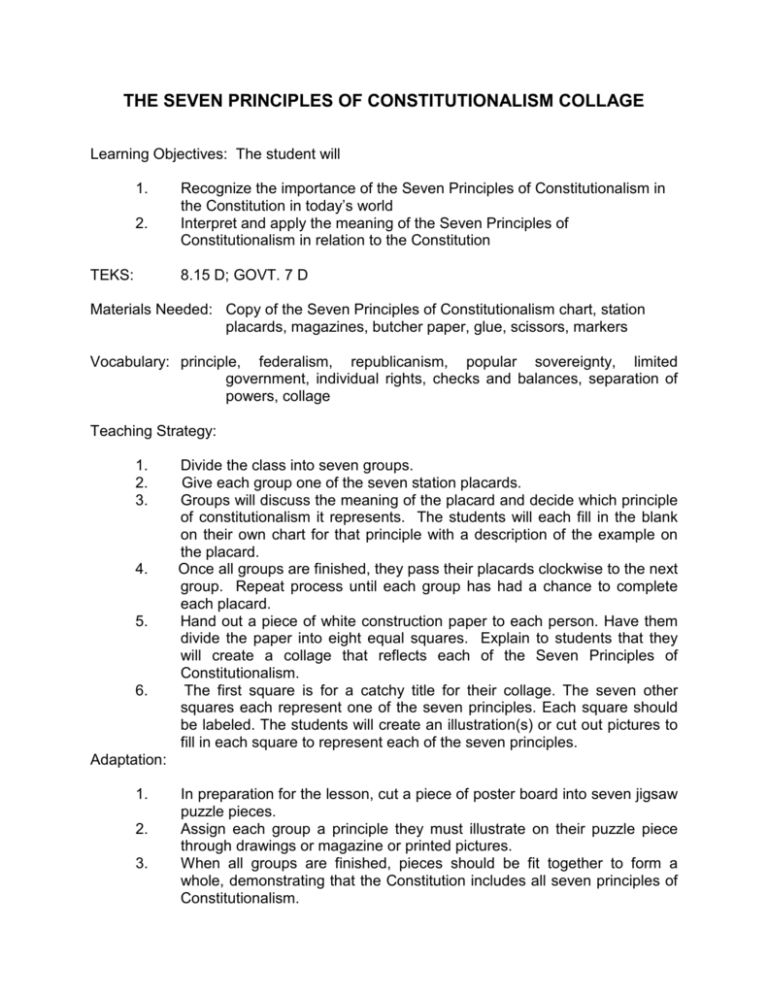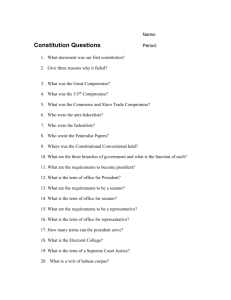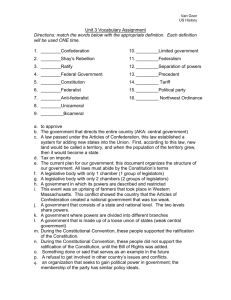
THE SEVEN PRINCIPLES OF CONSTITUTIONALISM COLLAGE
Learning Objectives: The student will
1.
2.
TEKS:
Recognize the importance of the Seven Principles of Constitutionalism in
the Constitution in today’s world
Interpret and apply the meaning of the Seven Principles of
Constitutionalism in relation to the Constitution
8.15 D; GOVT. 7 D
Materials Needed: Copy of the Seven Principles of Constitutionalism chart, station
placards, magazines, butcher paper, glue, scissors, markers
Vocabulary: principle, federalism, republicanism, popular sovereignty, limited
government, individual rights, checks and balances, separation of
powers, collage
Teaching Strategy:
1.
2.
3.
4.
5.
6.
Divide the class into seven groups.
Give each group one of the seven station placards.
Groups will discuss the meaning of the placard and decide which principle
of constitutionalism it represents. The students will each fill in the blank
on their own chart for that principle with a description of the example on
the placard.
Once all groups are finished, they pass their placards clockwise to the next
group. Repeat process until each group has had a chance to complete
each placard.
Hand out a piece of white construction paper to each person. Have them
divide the paper into eight equal squares. Explain to students that they
will create a collage that reflects each of the Seven Principles of
Constitutionalism.
The first square is for a catchy title for their collage. The seven other
squares each represent one of the seven principles. Each square should
be labeled. The students will create an illustration(s) or cut out pictures to
fill in each square to represent each of the seven principles.
Adaptation:
1.
2.
3.
In preparation for the lesson, cut a piece of poster board into seven jigsaw
puzzle pieces.
Assign each group a principle they must illustrate on their puzzle piece
through drawings or magazine or printed pictures.
When all groups are finished, pieces should be fit together to form a
whole, demonstrating that the Constitution includes all seven principles of
Constitutionalism.
Extension for GT/Pre-AP: Divide students into pairs. Students will use magazines,
newspapers and approved websites to find modern day articles illustrating how some
principles may be ignored or violated today. One student will prepare an explanation of
how this principle is being violated. The other student will explain where in the
Constitution this principle is found and how the violation might be corrected.
PRINCIPALES KEY—Station Placards
1—Checks & Balances
2—Individual Rights
3—Popular Sovereignty
4—Separation of Powers
5—Limited Government
6—Republicanism
7—Federalism
ConstitutionalismSeven Basic Principles Preserving Liberty
Constitutional
Principles
Explanation
Examples of How and Where It Is Achieved
Popular Sovereignty
Ultimate power and final
authority rest with “we the
people” or all the citizens
The Preamble to the U. S. Constitution
states: “We the People of the United States
…. do ordain and establish this Constitution
for the United States of America.”
Citizenship is defined in the 14th Amendment
added to the Constitution after the Civil War
in 1868. The right to vote was extended to
women by the 19th Amendment added in 1920
and to those 18 or older by the 26th
Amendment added in 1971.
Republicanism
The people exercise their power
by delegating it to
representatives chosen by them
through the election process.
The Constitution sets down a time frame for
regular elections for all elected government
positions. Article I provides for a bicameral
U. S. Congress comprised of a House of
Representatives all of whose members are
elected every two years and a U. S. Senate
whose members serve staggered six year
terms. Article II provides for a President and
a Vice President to be elected every four
years. Article IV obligates the national
government to guarantee each state “a
republican form of government.”
Federalism
Power is divided between the
central (national) government
and the state governments.
Some powers are concurrent and
thus held by both levels of
government (for example, the
power to tax).
The Constitution lists powers delegated to
the national government. For example,
Article I, Section 8 contains a lengthy list of
the powers of the U. S. Congress. Powers
not delegated to the national government and
not denied to the states are reserved to the
states or to the people by the 10th
Amendment.
Separation of Powers
Power within the national
government is divided among
three separate branches:
Legislative, Executive and
Judicial.
Article I creates a Legislative branch and
assigns that branch its duties and powers.
Article II creates an Executive branch and
assigns that branch its duties and powers.
Article III creates a Judicial branch and
assigns that branch its duties and powers.
ConstitutionalismSeven Basic Principles Preserving Liberty
Constitutional
Principles
Explanation
Examples of How and Where It Is Achieved
Checks and Balances
Each branch of the national
government has certain controls
(checks) over the other two
branches.
Article I, for example, gives Congress the
power to impeach, try, convict, and remove
from office officers of the other two
branches. Article I also gives the President
the power to veto any bill passed by the
Congress. Article II gives the President the
power to appoint judges of the Supreme
Court and other federal courts. Article III
does not specifically give the judicial branch
any check over the other two branches, but
the U. S. Supreme Court established a check
called judicial review over the other two
branches for itself in 1803 in a case called
Marbury v Madison.
Limited Government
Government’s power is limited
by the rule of law which
includes the Constitution and
the laws which are passed in
pursuance of that Constitution.
This means that government is
not all-powerful.
Limits on government, for example, are
imposed by the rights guaranteed to the
people by the U. S. Bill of Rights and by
Article I, Sections 9 and 10. Also, the
Supremacy Clause of Article VI makes the
Constitution, only those laws made in
pursuance of the Constitution, and treaties
the “Supreme Law of the Land.”
Individual Rights
Personal freedoms, personal
protections, and equality under
the law are guaranteed in the
Constitution, the Bill of Rights,
and laws of the U. S.
Article I, Section 9, for example, provides
that the privilege of the writ of habeas corpus
shall not be suspended except in time of
rebellion or invasion, that no bill of attainder
or ex post facto law shall be passed, and that
no titles of nobility shall be granted. The U.
S. Bill of Rights lists numerous other
individual rights. Due process of law and
equal protection of the law for all persons are
guaranteed by the Fourteenth Amendment.
All rights reserved. Permission is granted for these materials to be reproduced for classroom
use only. No part of these materials may be reproduced in any other form or for any other
purpose without the written consent of Law Related Education, State Bar of Texas.
For additional information on the LRE Program, please go to www.texaslre.org
1
2
3
U.S. GOVERNMENT
4
Don’t Leave Home
Without Them
CIVIL LIBERTIES
5
6
Some
powers are
just for
states.
Shared
Concurrent
Powers
States
Some
powers are
just for the
national or
central
government
Nation
7









